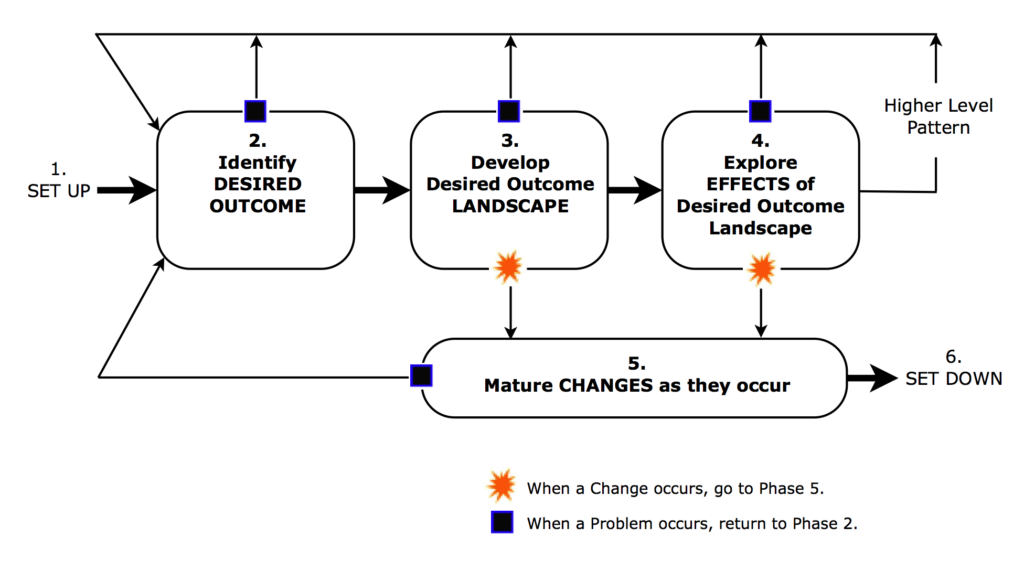The solutions to our problems are inherently embedded in the problems themselves
Paul Watzlawick, John H. Weakland & Richard Fisch. Change: Principles of Problem Formation and Problem Resolution
While Symbolic Modelling is an outcome-orientated approach, that doesn’t mean ignoring or avoiding problems, quite the contrary. Problems play a significant role in Penny Tompkins and my Problem-Remedy-Outcome (PRO) model. This aims to fully acknowledge clients’ problems – precisely as they experience them. Problems are also nearly always addressed in the ‘maturing changes’ phase.
The most important factor for me when considering whether to invite a client to attend to a problem (or not) is: For what purpose?
After that there are three other factors I take into account: When?, How?, and To what depth?
Below are 27 situations when I consider facilitating a person or group to self-model a problem.
Phases refer to our Symbolic Modelling Lite model.

Phase 2
- When they don’t have or can’t state a desired outcome
- When they repeatedly define their experience by what they don’t want
- When they habitually describe their problems
Phase 3
- When they can’t develop a desired outcome landscape in any detail
- When they can only attend to their desired outcome for a few moments at a time
- When their desired outcomes keep changing
- When desired outcomes are repeatedly attached to problems (dO but P)
- When a problem overwhelms their desired outcome
Phase 4
- When the desired outcome repeatedly leads to problems.
- When they know they can’t achieve their outcome and they can’t accept that.
- When the effects of a desired outcome are unacceptable and the desire cannot be given up or managed.
- When there are no acceptable solutions to a problem.
- When the proposed Remedy is the Problem.
- When the conditions necessary for a desired outcome to happen can’t be identified
- When the conditions necessary for a desired outcome to happen can’t be met.
- When the likely effects are a danger for (vulnerable or dependent) others.
- When the problem (or it’s effect) is realised as desirable.
Phase 5
- When changes keep resulting in problems
After Phase 6
- When they achieve their desired outcome but cannot sustain it.
- When they repeated fail to achieve what they say they want.
- When insights/learnings/changes in the session have no effect afterwards.
Other general conditions:
- To uncover a directly relevant desired outcome (rather than a very general outcome).
- To identify ‘choice point(s)’ before or during a problem pattern.
- To get their attention.
- When they don’t know they have a problem (but others know).
- When their ‘positive’ behaviour unintentionally keeps them from getting what they say they want.
- When it seems self-deception is having a substantial (unwanted) effect.
Postscript
Jacqueline Ann Surin added (19 April 2024):
And sometimes, a client might say, “I’d like to explore the problem so I can figure out what it’s all about.”
I replied:
Thanks for this neat suggestion. That makes 28!
The example client statement has an interesting surface structure:
desired Outcome “to explore” and then “figure out” a Problem.
As you know, generally I favour facilitating a client to experience exactly what they say they want. In this case, that would be to facilitate the client to self-model their problem landscape.
And at the same time, I wonder to myself: how will the client know they have “explored” the problem enough? And what will having “figured out” do for them?
Sometimes this kind of structure masks something deeper, for example:
- A common belief that we can only solve a problem when we have “figured out” the cause. (Whereas, experiencing an embodied desired outcome landscape can cast the problem in a new light and sometimes a client can ‘move on’ without ever having to ‘solve’ the problem.
-
A fear of having to make a change and therefore delaying by “exploring”. (You’ll notice the client doesn’t say they will do anything as a result of having “explored” and “figured out”.)
Even though, technically (according to the PRO model), it’s a desire Outcome statement, my first response would likely treat it as a proposed Remedy and ask:
And when you explore the problem and you figure out what it’s all about, then what happens?
Once there was some clarity on their purpose for exploring and figuring out, then my questions would go to exploring their perception of the problem.







